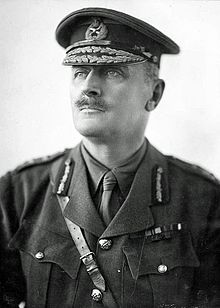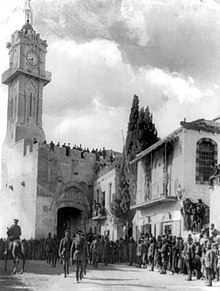Edmund Allenby, 1st Viscount Allenby
Edmund Henry Hynman Allenby, 1st Viscount Allenby GCB , GCMG , GCVO (born April 23, 1861 in Brackenhurst Hall , Nottinghamshire , † May 14, 1936 in London ) was a British field marshal who was particularly active in the First World War as commander of the Allied forces became famous in Sinai and Palestine in 1917/18 .
Life
Allenby first attended Haileybury and Imperial Service College . After failing two attempts to pass the Indian Civil Service entrance exam , he passed the exam for the Royal Military College at Sandhurst . Between 1884 and 1890 he was stationed in Bechuanaland ( Botswana ) and Zululand . He then returned to the United Kingdom with his cavalry regiment. There he attended the staff officer course at Staff College Camberley and was then stationed in Ireland for some time.
On December 30, 1896, he married Adelaide Mabel Chapman, the daughter of a Wiltshire landowner . With her he had his son Horace Michael Hynman Allenby (1898-1917).
Boer War
Allenby took part in the Second Boer War (1899-1902) as a commander of cavalry units. First as deputy battalion commander, then as chief of a cavalry squadron, he was involved in the defense of the northern border of the Cape Colony . He also took part in the liberation of the besieged city of Kimberley . He made the acquaintance of Cecil Rhodes . Later his unit was involved in the conquest of Bloemfontein , Johannesburg and Pretoria .
During the following guerrilla war, Allenby was then the commander of a mixed column that was in use until the end of the war, despite considerable loads. At this point he had attained the rank of colonel .
In the years before the First World War, Allenby was again promoted several times, in 1909 he was major-general inspector of cavalry troops. In this position he made few friends because of his brusque manners and pedantry. He was nicknamed "the bull" - also because of his stature.
First World War
Western front
During the First World War (1914 to 1918) Major General Allenby initially led the cavalry division on the Western Front , which covered the retreat of the British Expeditionary Force to the Marne after the battle of Mons . He was promoted to Lieutenant-General on October 10, 1914 and commanded the cavalry corps in the First Battle of Flanders . During the Second Battle of Flanders on May 6, 1915 he was appointed commander of the V Corps . In October 1915 he was promoted to commander of the 3rd Army on the Western Front.
A constant problem was Allenby's ongoing differences with Field Marshal Haig over tactical issues. After his troops failed to take advantage of a breakthrough at the Battle of Arras in 1917, he was replaced by Julian Byng as army commander.
Palestine Front
On June 28, 1917, Allenby was appointed Commander-in-Chief of British Forces in Egypt , the Egyptian Expeditionary Force (EEF), and began a successful offensive against the Ottoman Army on the Palestine Front . The last successful cavalry attack in history was led on October 31, 1917 under Allenby by the Australian 4th Light Horse Brigade and the British 5th Mounted Brigade in the conquest of Beersheba . On November 7th, he took Gaza , which had been heavily fortified by the German commanders of the Ottoman forces. Thereupon the Ottoman resistance collapsed and Allenby was able to conquer Jaffa on November 16 and Jerusalem on December 9 . As he marched into the old town, he insisted on walking to show his awe. The British press published a cartoon in which crusader Richard the Lionheart looked down at Jerusalem from heaven and said, “My dream came true after all.” Allenby later resisted claims that he spoke of it after conquering Jerusalem, “the crusade is now finished ".
In mid-January 1918, Allenby moved his headquarters from Kelab , about three kilometers southwest of Chan Yunis , to the school building of the Syrian orphanage in Bir Salem . There Chaim Weizmann and a Zionist delegation visited him on April 3, 1918, to demand Palestine as a state for the Jewish people after three days of antichambration . Allenby replied that his job was warfare and conquest, and that London was responsible for politics and affairs of state.
Allenby's troops had taken the coastal plain to the north of Tel Aviv and east of Petach Tikwas . Allenby's headquarters became one of the most photographed targets of aerial reconnaissance for the 304 Bavarian Air Force .
In the spring of 1918 British troops were relocated to the Western Front due to the German offensive there. This meant that further attacks were not possible for the time being. Even during this time, Allenby supported T. E. Lawrence , who drew the Arabs on the side of the British, financially to a considerable extent.
After Allenby was reinforced by troops from the British Empire , he prepared the last offensive from Bir Salem in September. On September 19, 1918, he defeated the Ottoman Army, which had been reinforced by some German troops ( Asia Corps ), at Megiddo . Two Ottoman armies were almost completely destroyed. He occupied Damascus on October 1, 1918 and Aleppo on October 25 .
post war period
After the Ottoman surrender Allenby became a field marshal and appointed as Viscount Allenby , of Megiddo and of Felixstowe in the county of Suffolk for peer applicable (7 October 1919).
From 1919 to 1925, Allenby was Reginald Wingates' successor, the British High Commissioner in the Sultanate of Egypt . Here he had to fight the nationalist unrest and strikes for the country's independence. Allenby pushed through the release of Egypt into independence against the British government , but at the same time secured the further influence of Great Britain. So stayed u. a. British troops still stationed in the country; especially Great Britain continued to control the Suez Canal .
In 1925 he retired from active service. Allenby died in London in 1936. He was cremated, his urn buried in Westminster Abbey next to Lord Plumers .
Since his only son had died as a soldier on the Western Front in 1917, his nephew Dudley Allenby inherited his title of nobility.
Others
The Allenby Bridge , which spans the Jordan River and connects Jericho in the West Bank with the Kingdom of Jordan , is named after him as the historically original bridge was built on his behalf in 1918.
Allenby was played by Jack Hawkins in David Lean's classic 1962 film Lawrence of Arabia .
The largest annual festival in Port Said is a carnival-like parade called al-Limbi in the spring on the first Monday after the Coptic Easter. The name is derived from Allenby, who, as a hated symbol of colonialism in the form of a straw doll clad with scraps of cloth, is carried through the streets at night and finally burned at a stake after midnight.
literature
- Lawrence James: Imperial warrior: the life and times of Field-Marshal Viscount Allenby 1861-1936. Weidenfeld and Nicolson, London 1993, ISBN 0-297-81152-5 .
- The Palestine News (Ed.): A brief record of the advance of the Egyptian expeditionary force under the command of General Sir Edmund HH Allenby, GCB, GCMB July 1917 to October 1918. Government Press and Survey of Egypt, Cairo 1919, archive. org
- Allenby, Edmund Henry Hyndman Allenby, 1st Viscount . In: Encyclopædia Britannica . 11th edition. tape 30 : Abbe - English history . London 1922, p. 113 (English, full text [ Wikisource ]).
Web links
- Field Marshal Edmund Henry Hynman Allenby, 1st Viscount Allenby of Megiddo on thepeerage.com , accessed September 17, 2016.
- Newspaper article about Edmund Allenby, 1st Viscount Allenby in the press kit 20th Century of the ZBW - Leibniz Information Center for Economics .
Individual evidence
- ↑ Andrew Curry: The First Holy War . In: US News and World Report , April 8, 2002.
- ↑ Jonathan Phillips: Holy Warriors. A modern History of the Crusades . Bodley Head, London 2009, ISBN 978-0-224-07937-2 , pp. 327-331.
- ↑ Barnet Litvinoff (ed.): The Letters and Papers of Chaim Weizmann. Transactions Books, Rutgers University, New Brunswick NJ 1984, ISBN 0-87855-297-9 / Israel Universities Press, Jerusalem 1984, ISBN 965-07-0003-X , Volume 2: December 1931 - April 1952 , p. 266.
- ↑ For aerial reconnaissance photos see Benjamin Ze'ev Kedar ( בנימין זאב קדר) and Moscheh Milner (משה מילנר, Photos), מבט ועוד מבט על ארץ־ישראל: תצלומי־אוויר מימי מלחמת העולם הראשונה מול תצלומים בני זמננו (Mabaṭ ṿe-ʻod mabaṭ ʻal Erets-Yiśraʼel: tatslume-aṿir mi-yeme Milḥemet ha-ʻOlam ha-Rishonah mul tatslumim bene zemanenu), יד יצחק בן־צבי (Yad Yitsḥaḳ Ben-Tsevi) and משרד הבטחון(Miśrad ha-biṭaḥon), Jerusalem / Tel Aviv 1991, ISBN 965-05-0586-5 .
- ↑ Barnet Litvinoff (ed.): The Letters and Papers of Chaim Weizmann. Transactions Books, Rutgers University, New Brunswick NJ 1983, ISBN 0-87855-297-9 / Israel Universities Press, Jerusalem 1983, ISBN 965-07-0003-X ; Volume 1: August 1898 - July 1931 , p. 172, footnote 1.
- ↑ Dietrich Rauschning : The dispute over the Suez Canal. Analysis, materials, bibliography. Research center for international law and foreign public law at the University of Hamburg, Hamburg 1956.
- ↑ Gabriele Braune: The Ḍamma and Simsimiyya repertoire in Port Saʿīd. In: Rüdiger Schumacher (ed.): From the diversity of musical culture. Festschrift for Josef Kuckertz . Ursula Müller-Speiser, Anif / Salzburg 1992, p. 99
| predecessor | Office | successor |
|---|---|---|
| Sir Archibald Murray | Commander in Chief of British Forces in Egypt and the Egyptian Expeditionary Force June 1917 to 1919 |
Sir Walter Norris Congreve |
| Reginald Wingate |
British High Commissioner for Egypt 1919–1925 |
George Lloyd |
| New title created |
Viscount Allenby 1919-1936 |
Dudley Allenby |
| personal data | |
|---|---|
| SURNAME | Allenby, Edmund, 1st Viscount Allenby |
| ALTERNATIVE NAMES | Allenby, Edmund |
| BRIEF DESCRIPTION | British Field Marshal |
| DATE OF BIRTH | April 23, 1861 |
| PLACE OF BIRTH | Brackenhurst Hall |
| DATE OF DEATH | May 14, 1936 |
| Place of death | London |

